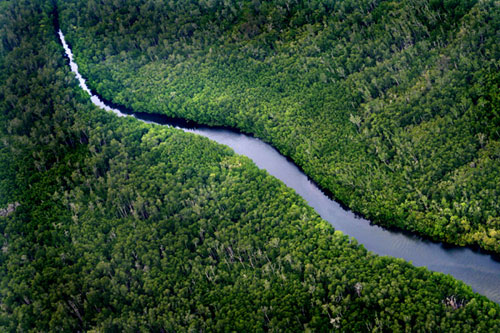Environmentalists and conservation people, including myself, are a whining lot. It's our professional affliction to complain about everything that is wrong about the world's environment and the conservation of its species. Where most people would look at a landscape and see beautiful views, green trees, and big skies, we see ecological devastation in the making, the wrong birds in those trees, and the signs of changing climate.
Now there is plenty to complain about, especially in a country like Indonesia with such a poor record of conservation and environmental management. What I want to make clear, though, is that despite our apparent pessimistic views, there is a huge sense of optimism and belief in a better world among many of us conservation folks. There is also great enjoyment in the work that we do. If it wasn't for that, we probably wouldn't have been here in the first place.
An obvious question anyone could ask me is: If it is all so bad, why do you even bother to work and live here? Why not go home to your own country and moan about the environment there? Leave Indonesian troubles for Indonesians to sort out, and go study rabbits in Dutch polder country.
One simple answer to this is that Indonesia is one of the most wonderful places on Earth to work in as a conservation scientist. It could hardly get more exciting and challenging. Don't get me wrong, rabbits are pretty cool, but studying their feeding habits cannot beat encountering an orangutan, tiger or bear somewhere deep in a tropical forest area, or trying to save these species from extinction.
Indonesia really is special. First of all, there are more species in this country than anywhere else in the world, apart from Brazil. The island of Borneo alone has some 633 species of bird, about the same as the whole of Europe, which is 15 times larger. There are at least 1,100 amphibian species in Indonesia, nearly four times as many as all of the amphibian species of Mexico, the United States and Canada combined. And some 75 percent of the coral species in the world occur in the waters in and around Indonesia. That is why they talk about "mega-diversity" here.
Maybe numbers of species aren't your thing, and you're more one for the visual experiences. Indonesia offers plenty of those, too. Seeing leopards and wild dogs stalk and kill deer and wild cattle on the grassland savannas of Baluran National Park in East Java is still among my best wildlife experiences ever.
And I will never forget the memories of diving in Komodo National Park over a reef teeming with fish, with below us three species of shark simultaneously cruising among them, and with an increasingly loud rattling and whistling that announced a group of bottlenose dolphins suddenly staring us in the eye.
You can't beat that for sheer exhilaration, and it would take a pretty jaded human being to not get at least some thrill out of such experiences.
Indonesia is so incredibly rich for a number of reasons. The Dutch referred to what is now Indonesia as the "Emerald Belt." And indeed Indonesia is like a long string of thousands of forest-clad islands. If anything stimulates speciation then it is island isolation and long-term climatic stability. Warm and humid conditions generally boost productivity and species richness too. On top of being a chain of tropical islands, Indonesia is also in an area where two major biotic zones meet, those from Asia and Australia. It would be nearly impossible to think of a better way to generate such vast species richness.
So, yes, the frustrations of being a conservationist in Indonesia are there. Most of the time, our work is an uphill struggle. My personal success rate after 22 years in this country of saving species or forest areas is depressingly low. And I am far from unique among fellow conservation-minded people and organizations. But the big question is, how much worse would things have been in the environment if we hadn't been here in the first place?
Indonesia often bears the brunt of negative publicity when it comes to environmental conservation. But in fact, compared to many other countries in Southeast Asia, this country is still in remarkably good shape. Nearby countries like Thailand, Malaysia and the Philippines retain far less forest than Indonesia. Wildlife poaching in countries like Cambodia and Vietnam is such that encountering wildlife is now pretty much impossible.
What is great about Indonesia is that there so much still worth protecting. And what is sad is that so little is done to effectively achieve that. That's the kind of internal conflict I go to bed and get up with again, day in and day out.
Because if Indonesia could really see what is right in front of it, it would realize that it has a resource in its hands that is unique, that no other country in the world has, and that can never be replaced. If nature functioned like a financial asset, Indonesia's irreplaceable ecosystems and species would make it among the wealthiest countries in the world.
So, yes, I can see the need for economic development, for plantations, mines, infrastructure and towns, and to some extent that will require the sacrifice of wild lands. But what I don't understand is why this has to happen in such a poorly planned and implemented manner. Balancing economic, social and environmental objectives could be done so much more effectively. That's why I would like to stay a little longer to see what I can contribute. That's why I bother.
Erik Meijaard is a Jakarta-based conservation scientist.
"Pay attention to the open skies"






